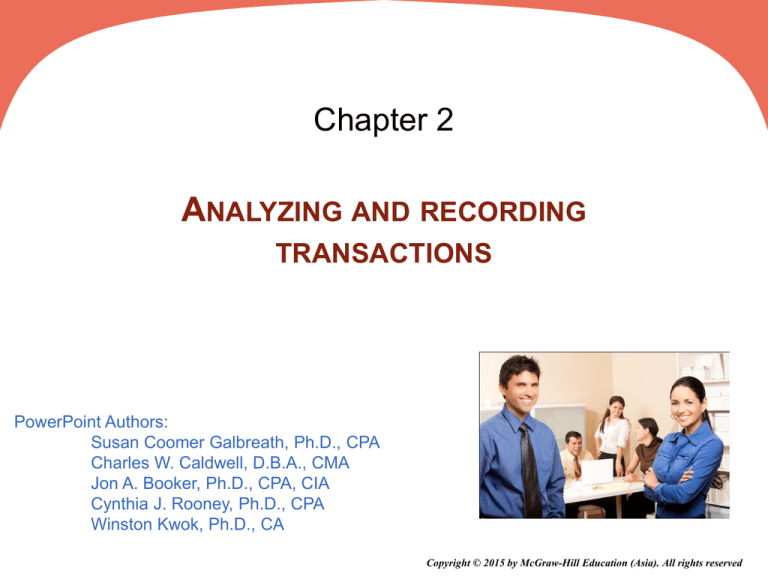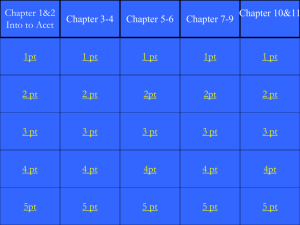
Chapter 2
ANALYZING AND RECORDING
TRANSACTIONS
PowerPoint Authors:
Susan Coomer Galbreath, Ph.D., CPA
Charles W. Caldwell, D.B.A., CMA
Jon A. Booker, Ph.D., CPA, CIA
Cynthia J. Rooney, Ph.D., CPA
Winston Kwok, Ph.D., CA
Copyright © 2015 by McGraw-Hill Education (Asia). All rights reserved
2-2
C1
ANALYZING AND RECORDING
PROCESS
Analyze each transaction and
event from source documents
Prepare and analyze
the trial balance
Record relevant transactions
and events in a journal
Post journal information
to ledger accounts
2-3
C1
SOURCE DOCUMENTS
Checks
Employee
Earnings
Records
Bills from
Suppliers
Purchase
Orders
Bank
Statements
Sales
Tickets
2-4
C2
THE ACCOUNT AND ITS ANALYSIS
An account is a
record of
increases and
decreases in a
specific asset,
liability, equity,
revenue, or
expense item.
The general
ledger is a record
containing all
accounts used by
the company.
2-5
C2
THE ACCOUNT AND ITS ANALYSIS
Owner, Capital
Owner, Withdrawals
2-6
C2
ASSET ACCOUNTS
Cash
Land
Buildings
Asset
Accounts
Accounts
Receivable
Notes
Receivable
Prepaid
Accounts
Equipment
Supplies
2-7
C2
LIABILITY ACCOUNTS
Accounts
Payable
Notes
Payable
Liability
Accounts
Accrued
Liabilities
Unearned
Revenue
2-8
C2
EQUITY ACCOUNTS
Owner’s
Capital
Owner’s
Withdrawals
Equity
Accounts
Revenues
Expenses
2-9
C2
THE ACCOUNT AND ITS ANALYSIS
Assets
+
Owner’s
Capital
=
Liabilities
+
–
+
Owner's
Withdrawals
Revenues
Equity
–
Expenses
2 - 10
C3
LEDGER AND CHART OF ACCOUNTS
The ledger is a collection of all accounts for an
information system. A company’s size and diversity
of operations affect the number of accounts needed.
The chart of accounts is a list of all accounts and includes an
identifying number for each account.
Account Number
101
106
126
128
167
201
236
301
Account Name
Cash
Accounts receivable
Supplies
Prepaid insurance
Equipment
Accounts payable
Unearned revenue
C. Taylor, Capital
Account Number
302
403
406
622
637
640
652
690
Account Name
C. Taylor, Withdrawals
Revenues
Rental revenue
Salaries expense
Insurance expense
Rent expense
Supplies expense
Utilities expense
2 - 11
C4
DEBITS AND CREDITS
A T-account represents a ledger account and
is a tool used to understand the effects of
one or more transactions.
Account Title
(Left side)
(Right side)
Debit
Credit
2 - 12
C4
DOUBLE-ENTRY ACCOUNTING
Assets
ASSETS
Debit
+
Normal
=
Liabilities
LIABILITIES
Credit
-
Debit
-
Credit
+
Normal
+
Equity
EQUITIES
Debit
-
Credit
+
Normal
2 - 13
C4
DOUBLE-ENTRY ACCOUNTING
Equity
Owner’s
Capital
_
Owner’s
Withdrawals
+
Revenues
Owner’s
Capital
Owner’s
Withdrawals
Revenues
Debit Credit
Debit Credit
Debit Credit
-
+
+
-
-
+
_ Expenses
Expenses
Debit Credit
+
-
2 - 14
C4
DOUBLE-ENTRY ACCOUNTING
An account balance is the difference between the increases
and decreases in an account. Notice the T-Account.
2 - 15
P1
JOURNALIZING &
POSTING TRANSACTIONS
Assets
=
Liabilities
+
Equity
T- Account
(Left side)
(Right side)
Debit
Credit
Step 1: Analyze
transactions and source
documents.
ACCOUNT NAME:
Date
Step 2: Apply doubleentry accounting
GENERAL JOURNAL
ACCOUNT No.
Description
PR
Debit
Credit
Balance
Step 4: Post entry to ledger
Date
Description
Page
Post.
Ref.
Debit
123
Credit
Step 3: Record journal entry
2 - 16
P1
JOURNALIZING TRANSACTIONS
Transaction
Date
Date
2011
Dec. 1 Cash
Titles of Affected
Accounts
Description
Debit
30,000
C. Taylor, Capital
To record investment of cash by owner
Dec. 2 Supplies
Cash
To record purchase of supplies with cash
Transaction
explanation
Credit
30,000
2,500
2,500
Dollar amount of debits
and credits
2 - 17
P1
BALANCE COLUMN ACCOUNT
T-accounts are useful illustrations, but balance
column ledger accounts are used in practice.
CASH
Date
ACCOUNT No. 101
Description
PR
Debit
G1
30,000
Credit
Balance
2,500
26,000
30,000
27,500
1,500
5,700
2011
Dec. 1
Dec. 2
Dec. 3
Dec. 10
Initial investment
Purchased supplies
Purchased equipment
Collection from customer
G1
G1
G1
4,200
2 - 18
P1
POSTING JOURNAL ENTRIES
1 Cash
30,000
C. Taylor, Capital
To record investment of cash by owner
1
30,000
Identify the debit account in ledger.
CASH
Date
2015
ACCOUNT No.
Description
PR
Debit
Credit
101
Balance
2 - 19
P1
POSTING JOURNAL ENTRIES
2015
Dec. 1 Cash
30,000
C. Taylor, Capital
To record investment of cash by owner
2
30,000
Enter the date.
CASH
Date
2015
Dec. 1
ACCOUNT No.
Description
PR
Debit
Credit
101
Balance
2 - 20
P1
POSTING JOURNAL ENTRIES
2015
Dec. 1 Cash
30,000
C. Taylor, Capital
To record investment of cash by owner
3
30,000
Enter the amount and description.
CASH
Date
ACCOUNT No.
Description
PR
Debit
Credit
101
Balance
2015
Dec. 1
Investment by owner
Dec. 3
Purchased equipment
30,000
G1
20,000
(20,000)
2 - 21
P1
POSTING JOURNAL ENTRIES
2015
Dec. 1 Cash
30,000
C. Taylor, Capital
To record investment of cash by owner
4
30,000
Enter the journal reference.
CASH
Date
ACCOUNT No.
Description
PR
Dec. 1
Investment by owner
G1
Dec. 3
Purchased equipment
G1
Debit
Credit
101
Balance
2015
30,000
20,000
(20,000)
2 - 22
P1
POSTING JOURNAL ENTRIES
2015
Dec. 1 Cash
30,000
C. Taylor, Capital
To record investment of cash by owner
5
30,000
Compute the balance.
CASH
Date
ACCOUNT No.
Description
PR
Investment by owner
G1
Debit
Credit
101
Balance
2015
Dec. 1
30,000
30,000
2 - 23
P1
POSTING JOURNAL ENTRIES
2015
Dec. 1 Cash
101
30,000
C. Taylor, Capital
To record investment of cash by owner
6
30,000
Enter the ledger reference.
CASH
Date
ACCOUNT No.
Description
PR
Dec. 1
Investment by owner
G1
Dec. 3
Purchased equipment
G1
Debit
Credit
101
Balance
2015
30,000
30,000
20,000
(20,000)
2 - 24
A1
ANALYZING TRANSACTIONS
Owner invested $30,000 in FastForward on Dec. 1.
Transaction:
Analysis:
Assets
=
Liabilities
+
Cash
30,000
Equity
Capital
30,000
Posting:
(1)
Cash
30,000
101
C. Taylor, Capital
(1)
301 301
30,000
2 - 25
A1
ANALYZING TRANSACTIONS
Transaction:
FastForward purchases supplies by paying $2,500
cash.
Analysis:
Cash
(2,500)
Assets
Supplies
2,500
=
+
Liabilities
Equity
Capital
Double entry:
(2)
Supplies
Cash
126
101
2,500
2,500
Posting:
(2)
Supplies
2,500
126
(1)
Cash
30,000
101
(2)
2,500
2 - 26
A1
ANALYZING TRANSACTIONS
Transaction:
FastForward purchases equipment by paying $26,000
cash.
Analysis:
Assets
Cash Equipment
(26,000)
26,000
=
Liabilities
+
Equity
Capital
Double entry:
(3)
Equipment
Cash
167
101
26,000
26,000
Posting:
(3)
Equipment
26,000
167
(1)
Cash
30,000
101
(2)
(3)
2,500
26,000
2 - 27
A1
ANALYZING TRANSACTIONS
Transaction:
FastForward purchases $7,100 of supplies on credit.
Analysis:
Assets
=
Supplies
7,100
Liabilities
Accounts Payable
7,100
+
Equity
Capital
Double entry:
(4)
Supplies
Accounts payable
126
201
7,100
7,100
Posting:
(2)
(4)
Supplies
2,500
7,100
126
Accounts Payable
(4)
201
7,100
2 - 28
A1
ANALYZING TRANSACTIONS
Transaction:
FastForward provides consulting services and
immediately collects $4,200 cash.
Analysis:
Assets
=
Liabilities
+
Cash
4,200
Equity
Revenue
4,200
Double entry:
(5)
Cash
Consulting Revenue
101
403
4,200
4,200
Posting:
(1)
(5)
Cash
30,000
4,200
(2)
(3)
101
403
2,500
26,000
Consulting Revenue 101
403
(5)
4,200
2 - 29
P2
After processing its remaining transactions for
December, FastForward’s Trial Balance is prepared.
FastForward
Trial Balance
December 31, 2015
Cash
Accounts receivable
Supplies
Prepaid Insurance
Equipment
Accounts payable
Unearned consulting revenue
C. Taylor, Capital
Owner's Withdrawals
Consulting revenue
Rental revenue
Salaries expense
Rent expense
Utilities expense
Total
Debits
$ 4,350
9,720
2,400
26,000
Credits
$
6,200
3,000
30,000
200
5,800
300
1,400
1,000
230
$ 45,300 $ 45,300
The trial balance
lists all account
balances in the
general ledger. If
the books are in
balance, the total
debits will equal the
total credits.
2 - 30
P2
PREPARING A TRIAL BALANCE
Preparing a trail balance involves three steps:
1.List each account title and its amount (from
ledger) in the trial balance. If an account has
a zero balance, list it with a zero in the
normal balance column (or omit it entirely).
2.Compute the total of debit balances and the
total of credit balances.
3.Verify (prove) total debit balances equal total
credit balances.
2 - 31
P2
SEARCHING FOR AND CORRECTING
ERRORS
If the trial balance does not balance, the
error(s) must be found and corrected.
Make sure the trial
balance columns are
correctly added.
Re-compute each
account balance in the
ledger.
Make sure account
balances are correctly
entered from the ledger.
Verify that each journal
entry is posted correctly.
See if debit or credit
accounts are mistakenly
placed on the trial balance.
Verify that each original
journal entry has equal
debits and credits.
2 - 32
P3
USING A TRIAL BALANCE TO PREPARE
FINANCIAL STATEMENTS
2 - 33
P3
INCOME STATEMENT
FASTFORWARD
Income Statement
For the Month Ended December 31, 2015
Revenues:
Consulting revenue
$ 5,800
Rental revenue
300
Total revenues
$ 6,100
Expenses:
Rent expense
(1,000)
Salaries expense
(1,400)
Utilities expense
(230)
Total expenses
(2,630)
Net profit
$ 3,470
2 - 34
P3
STATEMENT OF CHANGES IN EQUITY
FASTFORWARD
FASTFORWARD
Statement of Changes in Equity
For the Month Ended December 31, 2015
C. Taylor, Capital 12/1/15
Investment by Owner
Connections
FASTFORWARD
Income Statement
For the Month Ended December 31, 2015
Revenues:
Consulting revenue
$
5,800
Rental revenue
300
Total revenues
$
Expenses:
Rent expense
(1,000)
Salaries expense
(1,400)
Utilities expense
(230)
Total expenses
Net profit
$
$
30,000
Net profit
Owner Withdrawals
C. Taylor, Capital, 12/31/15
6,100
(2,630)
3,470
-
$
3,470
33,470
(200)
33,270
2 - 35
P3
STATEMENT OF FINANCIAL POSITION
FASTFORWARD
Statement of Changes in Equity
For the Month Ended December 31, 2015
C. Taylor, Capital 12/1/15
Net profit for December
Plus: Investments by Owner
Less: Owner Withdrawals
C. Taylor, Capital, 12/31/15
$
$
Connections
3,470
30,000
33,470
(200)
33,270
FASTFORWARD
Statement of Financial Position
December 31, 2015
Assets
Cash
$
4,350
Supplies
9,720
Prepaid insurance
2,400
Equipment
26,000
Total assets
$
42,470
Liabilities
Accounts payable
$
6,200
Unearned revenue
3,000
Total liabilities
9,200
Equity
C. Taylor, Capital
Total equity
Total liabilities and equity
$
$
33,270
33,270
42,470
2 - 36
P3
PRESENTATION ISSUES
1. Dollar signs are not used in journals and ledgers.
2. Dollar signs appear in financial statements and other
reports such as trial balances. The usual practice is to
put dollar signs beside only the first and last numbers
in a column.
3. When amounts are entered in the journal, ledger, or
trial balance, commas are optional to indicate
thousands, millions, and so forth.
4. Commas are always used in financial statements.
5. Companies commonly round amounts in reports to the
nearest dollar, or even to a higher level.
2 - 37
A2
Debt Ratio
Total Liabilities
Debt Ratio =
Total Assets
Evaluates the level of debt risk.
A higher ratio indicates that there is a
greater probability that a company will not
be able to pay its debt in the future.
2 - 38
END OF CHAPTER 2





